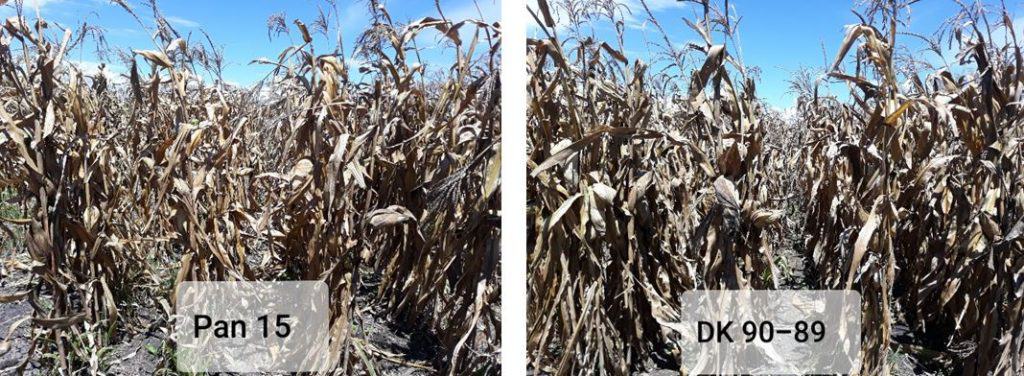
Choosing the right variety is important for any crop, but with a crop like maize where there is just so much choice, where do you start?
Last season we carried out four fully replicated maize variety trials in the highland areas; in Timau, Rumuruti, Nakuru and Eldoret to independently compare a range of maize varieties and provide farmers with the knowledge.
Up to 17 maize varieties were grown at each site based on what we know is reasonably well adapted the each area, taken to yield at harvest, and this is what we found…

Starting at home with Kenya Seeds, 6218 surprised us with its standing power and high yields. Disease resistance was particularly strong, notably at the Eldoret site where many maize varieties were showing significant Grey Leaf Spot despite two fungicides. 6218 is clearly not designed with machine harvesting in mind and the high cob height is a real challenge. Grain quality was just above average and seed germination at the beginning was good.
6213 stood less well at all sites and was yielding around 5% at least below 6218 as would be expected. Disease resistance was ok but once again, maize cob height limited the appeal of the variety to those planning to combine the crop, and 6218 is a definite step forward.
We also looked at 624 and 629 however these were even further below 6213 in yield, and offered little agronomic or quality benefit.
On to 30G19, this popular maize variety disappointed at all sites, and struggled with grain quality and in particular standing power at higher plant populations. It is an unpopular comment, but blaming a variety with weak stems for poor performance is like turning up to a football match barefoot; fine until the rest of the team are wearing studs. Having said that, 30G19 shows good grain quality provided it is harvested in good time.
Also from Pioneer, P3812W impressed again at all sites for its standing power and cob droop; this is a variety that excels at what most countries and agronomists would consider normal populations for a maize crop. Rust needs to be managed, but the crop is very even and the seed flow through the planters was excellent. This is also a variety with tolerance to nicosulfuron which will be a very important herbicide in years to come.
The venerable 691 was a consistent performing maize variety that did not disappoint at any of the sites, however grain quality was not the best and yield is now well behind the top varieties, sitting 15-20% below the top varieties at each site.
Pan 15 was excellent and was in the top three varieties at three of the sites, however grain quality is an issue with a low level of Diplodia in some cobs, and Watery Rots at all site. This can however be managed with prompt harvesting of what is otherwise a very solid variety.

From Monsanto, DK 90-89 was not the top yielder in any of the trials but it tended to be in the top third of varieties for yield, was extremely consistent and produced excellent quality white grain. Slightly stronger on Rust than P3812W, the disease still needs managing, however Grey Leaf Spot resistance is good and standing power excellent.
DK 777 was probably the biggest surprise in the trials this year. Whilst not included at every site, the variety is exceptionally even and has the characteristic that Americans would call a “fix ear” where cob size appeared to diminish very slowly as plant population increases. Yield appears to be around 10% above 90-89 and just below the very best varieties. Grain quality was excellent.
We included DK 8031 and 8033 to compare some really early material that was obviously unsuitable for all of these sites except perhaps Rumuruti and sure enough yields were around 40% lower than the best high altitude varieties. Nonetheless this got us thinking about the opportunities for double cropping and following behind with a crop of peas for example to put some diversity into the cropping system.
7m-81 was a variety that shone in the warmer environments, as did Syngenta’s SY 594. 7m-81 has very even cob fill and short plants which facilitated late foliar nutrient and fungicide applications, whilst SY 594 had a slight issue with germination even with the two batched of seed purchased. The stems did break in all of the trials well before many other varieties so lodging risk clearly has to be managed carefully.
Both 7m-81 and SY594 both yielded in the top 10% of varieties and along with DK 777 have the characteristics such as very even plant stature that will really allow us to push them with nutrition and plant populations.
SC Twiga 83 and 600-23A were below average yield and grain quality, with significant lodging in 600-23A, but produced large amounts of green material for farmers wanting forage.
Despite the range of conditions and planting dates there are some very clear messages, especially in the plant population trials which will be covered in depth in a future Think Agronomy articles. But the main messages are to choose a proven variety with reliable grain quality, and give it the best chance with accurate planting, nutrition and weed control.

Just because a variety is not listed above does not mean that it is not worth considering. However in order to produce meaningful and accurate data, the large number of plots in the trial necessitated that we did could not include every variety, so decisions were made based on local agronomic experience as to which varieties were likely to have a good chance of performing.
DISCLAIMER:
1. The information and recommendations for seed varieties, including quality, viability, and performance, are based on specific tests conducted by an independent agronomist. These results apply only to the tested seed sample and conditions. No warranty, express or implied, is provided for recommended seed varieties. The recommendation list is not exhaustive, and omission does not imply inferiority.
2. Information and recommendations for seed varieties are derived from test results and practical experience of an independent agronomist. Tests may not cover all conditions, and we do not guarantee similar results. Recommended varieties may not be suitable for all use conditions; the user must determine suitability based on local conditions and agronomic practices.
3. This article’s information is for general consumer assistance, and we are not liable to any user for the provided information under any circumstances.
Till next time,
happy farming!
David

David Jones is the Broad Acre Specialist at Crop Nutrition Laboratory Services Ltd. (CROPNUTS). David has a keen interest in soils and no till farming systems where he has undertaken work looking into weed levels and changes in soil structure, and has extensive experience in field trials and in the development of precision farming techniques. In his spare time he enjoys playing rugby.
Order our services and get to know how to improve your soil for better yeilds.